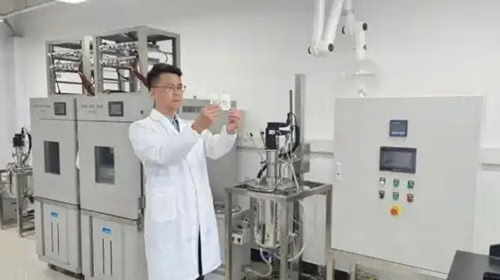Sodium tripolyphosphate (STPP) is a widely used chemical in detergents, such as washing powders and detergents to improve their properties.

I. The role of sodium tripolyphosphate in detergent
A.Softening water:
Sodium tripolyphosphate can combine these metal ions inside the hard mater, with its own phosphate to form insoluble calcium phosphate and other salts, thus softening the water quality and improving the washing effect.
B.Dispersing stains:
Surfactants in detergents can emulsify stains, but if the stains are not evenly dispersed, they are prone to recontamination. Sodium tripolyphosphate can disperse the stains so that they are evenly dispersed in the solution, preventing the recontamination phenomenon.
C.Improve detergent quality:
The quality of the ingredients in detergent varies, and sometimes there are impurities such as inferior ingredients or by-products, which may affect the washing effect or cause damage to clothes. Sodium tripolyphosphate can be used as a dosage regulator to improve the quality of detergents.

D.Enhances the alkalinity of detergents:
Sodium tripolyphosphate is an alkaline substance that enhances the alkalinity of detergents and improves the washing effect.
E.Prevents caking:
Sodium tripolyphosphate can keep the detergent in dry granular form and prevent caking due to water absorption.
F.Chelating effect:
Sodium tripolyphosphate has a chelating effect on metal ions, which can eliminate the unfavorable effects of metal ions on washing and improve the washing effect.
G.Emulsifying and dispersing effect:
Sodium tripolyphosphate has swelling and solubilizing effect on proteins, promoting emulsifying effect on fats, and dispersing effect on solid dirt.
H. Buffering effect:
sodium tripolyphosphate has alkaline buffering effect, which is beneficial to the removal of acidic dirt.
In fact, these effects are applied in many other field too, please read sodium tripolyphosphate uses for the specific description.
II. Can sodium tripolyphosphate be used directly as a detergent?
No.
Sodium tripolyphosphate should not be used directly as a detergent. Sodium tripolyphosphate can cause skin irritation and damage when used directly, as well as damage to clothing. In addition, excessive use of detergents containing sodium tripolyphosphate can leave residues in the laundry, which not only affects the aesthetics of the clothes, but also damages the fabric fibers and reduces the life of the clothes.
III. Limits of sodium tripolyphosphate in detergents
Although sodium tripolyphosphate can improve the washing effect, it can lead to eutrophication of water bodies, trigger algae outbreaks, reduce the oxygen content of water, and endanger the aquatic organisms. Therefore, many countries have put forward standards on the amount of sodium tripolyphosphate used in these limits, in order to reduce the adverse effects of sodium tripolyphosphate on the environment.

Limit standards of different countries:
- China: According to the relevant regulations in China, the amount of sodium tripolyphosphate shall not exceed 2.2g per 100g of detergent.
- EU: The maximum content of sodium tripolyphosphate per kilogram of detergent in the EU is 10g.
- U.S.A.: The U.S. Environmental Protection Agency (EPA) stipulates that the maximum content of sodium tripolyphosphate per kilogram of detergent is 10g.
Consumers should follow product instructions and recommended dosages to avoid overuse, and choose products produced by regular manufacturers with quality assurance.
IV. Market Application of Substitute Auxiliaries

Because of the adverse effects of sodium tripolyphosphate on the environment, a number of additives have been developed that can replace sodium tripolyphosphate in detergents. The main types are as follows: layered crystalline sodium disilicate, 4A zeolite, disodium EDTA, sodium acetate, magnesium sulfate, disodium hydrogen phosphate, sodium dihydrogen phosphate, and so on.
These alternative additives can reduce the pollution of the environment, and to a certain extent can replace the performance of sodium tripolyphosphate. However, complete replacements for sodium tripolyphosphate are not yet available, and most of the alternative additives need to be used under specific conditions to achieve optimal washing results.
V. Conclusion
Sodium tripolyphosphate plays a crucial role in detergents and other industries. Its unique chemical properties and preparation methods make it an important chemical compound. However, its use also needs to be carefully monitored to ensure environmental and health safety.
Sodium tripolyphosphate (STPP) is indeed a vital compound in the detergent industry as well as in other sectors. Despite the many benefits of STPP, its use needs to be carefully monitored. The environmental impact of STPP, especially its potential to cause water pollution if not properly managed, is a concern.
Additionally, its low toxicity poses a risk if ingested in large quantities. Besides, many substiture auxiliaries are developped to replace sodium tripolyphosphate in detergents, however, complete replacements for STPP are not yet available. The sodium tripolyphosphate is still active in the detergent industry.
In conclusion, while sodium tripolyphosphate is a valuable chemical compound with numerous applications, its use must be balanced with environmental and health considerations. Continued research and development are needed to find more sustainable and safe alternatives while still maintaining the effectiveness of products that rely on STPP.
Related concern:

